Despite wide speculation over whether an en primeur campaign could proceed at all in 2020, this year’s campaign is now more or less complete, and Wine Lister’s scores are in. Bordeaux 2019s exhibit high quality across the board, receiving frequent comparison with recent great vintages – 2016, 2015, 2010, and 2009.
Wine Lister has now published its latest Wine Leagues on the new vintage – examining which Bordeaux 2019s rank best for WL score in each major appellation.
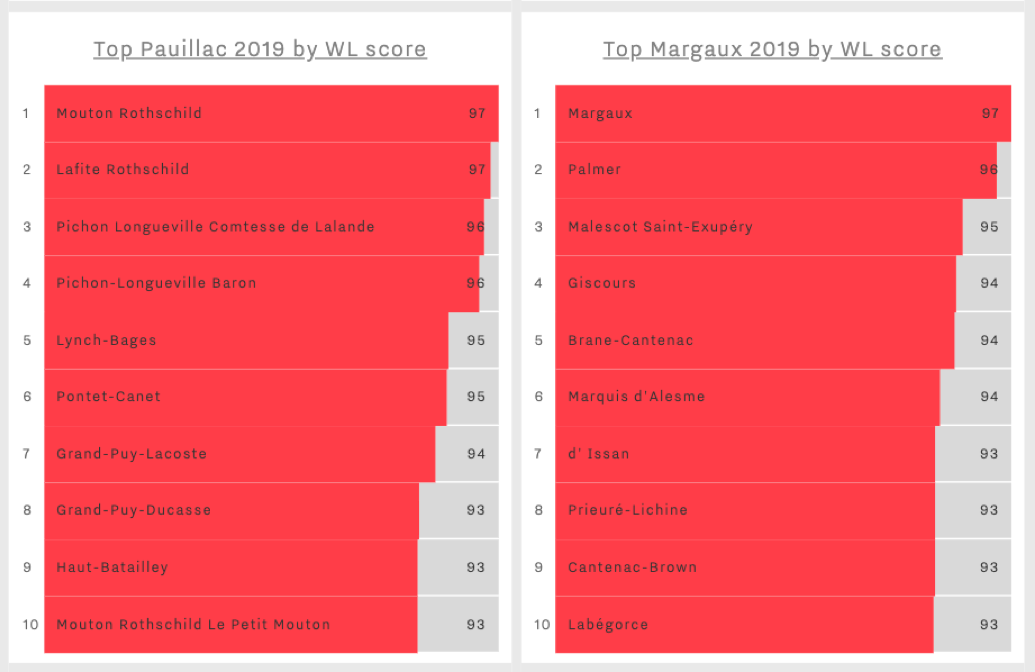
Pauillac First Growths, Lafite and Mouton, lead the appellation’s league of top 2019s by WL score, with a joint score of 97. Pichon Comtesse and Pichon Baron follow suit with 96 – the latter achieving its highest WL score since its 2016 vintage. Wine Lister partner critic Neal Martin describes Pichon-Baron 2019 as having “a very refined bouquet” and a “silky smooth, creamy texture”, stating it “retains all the classicism you could ask for”.
The league of Margaux 2019s by WL score is topped by the appellation’s namesake property, whose latest release joins fellow Pauillac Firsts with a score of 97. Following Palmer’s entry with 96, Malescot Saint-Exupéry 2019 achieves the château’s highest ever WL score (95). Wine Lister partner critic, Antonio Galloni notes that the 2019 is “a striking wine that is sure to find many admirers”, recounting an “interplay of earthy and savoury notes with rich, dense fruit… utterly captivating”.
There are four Value picks featured in the league of Margaux 2019s by WL score, with Labégorce, Malescot Saint-Exupéry, Marquis d’Alesme, and Prieuré-Lichine all achieving scores of 93 and above, at under £35 per bottle (in-bond).
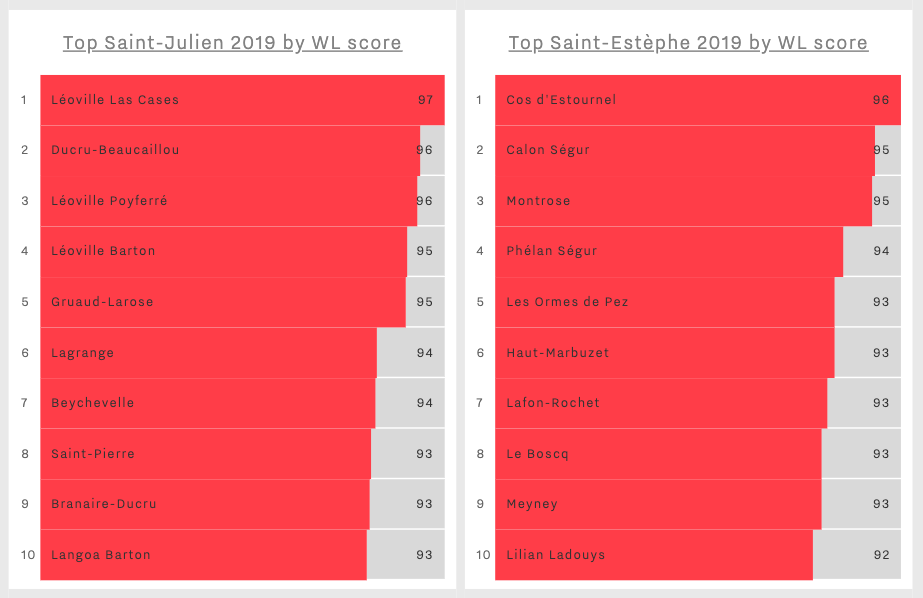
In Saint-Julien, Léoville Las Cases 2019 achieves a WL score of 97, matching that of its 2018 and 2016 vintages. Ducru-Beaucaillou and Léoville Poyferré appear in joint-second place with 96 – achieving their highest WL scores since 2016 and 2015, respectively. Ducru-Beaucaillou 2019 performed notably well at tastings, with Neal Martin, awarding it 96-98 points. He notes its “filigree tannins, pitch perfect acidity and a sensual, satin-like texture”, concluding that the wine is “outstanding in terms of persistence”.
With a score of 96, Cos d’Estournel 2019 tops the league for Saint-Estèphe 2019s by WL score, matching its successful 2018 and 2016 vintages. Writing for JancisRobinson.com, James Lawther describes the vintage as “powerful but carefully constructed and precise”, noting “a lovely mellow quality to such a muscular wine”. While both falling one WL score below their previous vintage, Calon Ségur and Montrose appear second in the appellation’s league, with a shared score of 95.
Branaire-Ducru 2019 and Meyney 2019 exhibit notable value within their appellations – both achieving WL scores of 93 at £29 and £19 per bottle (in-bond), respectively.
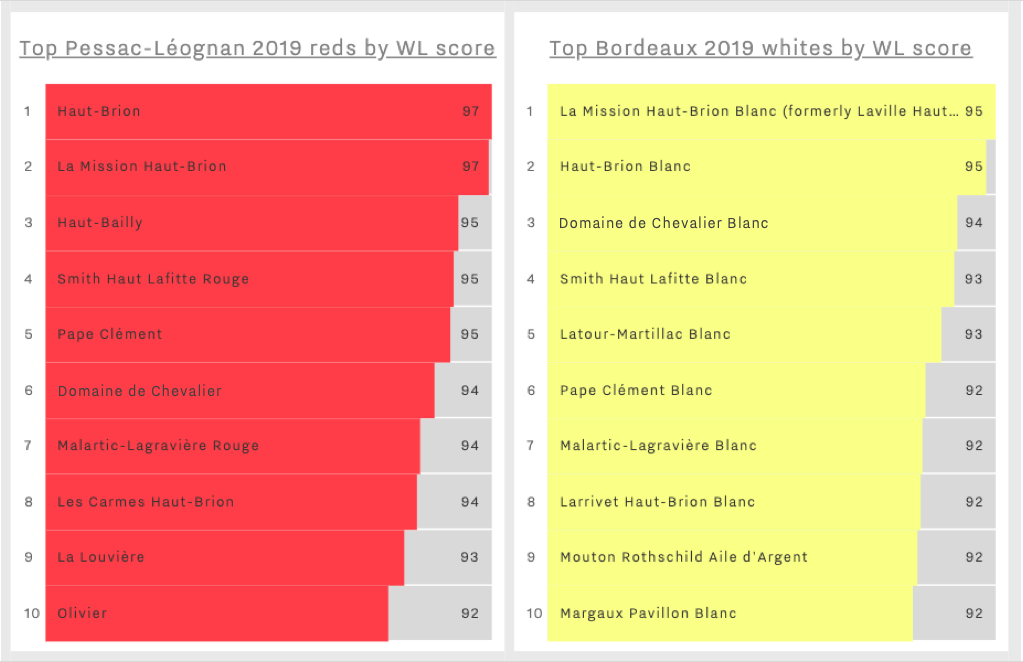
Haut-Brion and La Mission Haut-Brion perform notably well in 2019, achieving joint-first place in the league of top Pessac-Léognan 2019 reds by WL score. As examined in a previous Bordeaux 2019 en primeur blog, the en primeur darling, Les Carmes Haut-Brion, shows clear qualitative success in 2019, and its small production levels and smart en primeur pricing has once again made it a clear campaign buy. Another promising pick from Pessac-Léognan, Olivier 2019 achieves Value pick status at c.£20 per bottle (in-bond), and achieves the château’s highest WL score (92). Antonio Galloni recounts “smoke, licorice, cured meat, graphite and savory herbs infuse the 2019 with striking aromatic intensity to play off its sumptuous fruit”, concluding that the wine is “Very good”.
Haut-Brion and La Mission Haut-Brion attain joint-first place for their whites as well as reds in 2019, achieving scores of 95 in the league of top Bordeaux 2019 whites by WL score. Latour-Martillac Blanc 2019 achieves the highest WL score seen across its vintages (93) – one WL score above Pape Clément Blanc’s 92. At c.£21 per bottle (in bond) Latour-Martillac Blanc 2019 enters the market 10-30% below the current market prices of vintages 2016-2018, showing good value for its quality. Neal Martin notes on the latest vintage: “subtle tropical notes of pineapple and orange rind with hints of strawberry come through on the finish”.
On the right bank, the league of top 10 Saint-Emilion 2019s is crowned by Figeac’s high-scoring 2019. Up one point on its 2018, Figeac’s latest release achieves the highest WL score of all Bordeaux 2019s (98). Figeac 2019 illustrates the château’s impressive upward quality trajectory, which has seen its WL score slowly but surely increase from 91 in 2008. Neal Martin gives the latest vintage 97-99 points, describing it as “exquisitely defined… a deeply impressive, intellectual Figeac”.
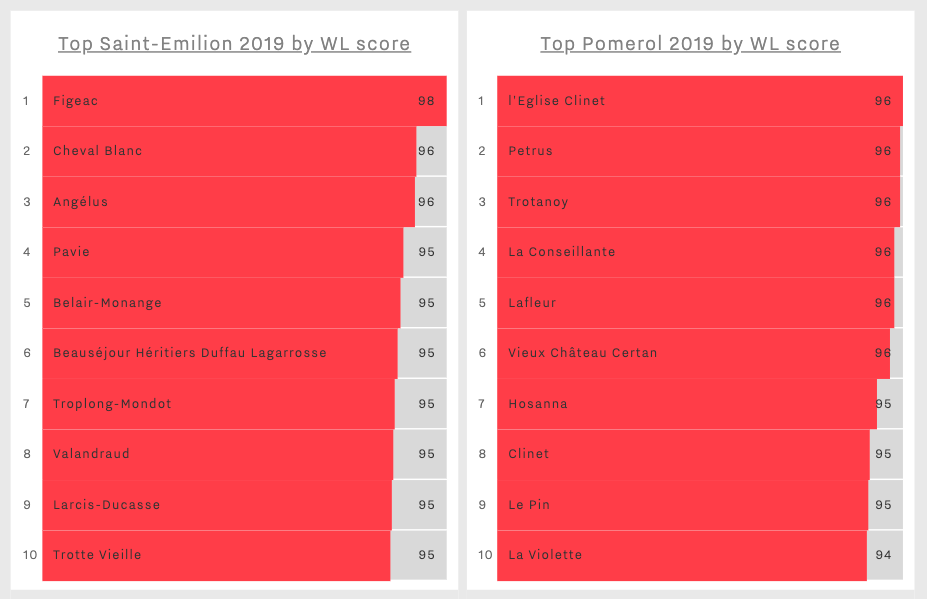
La Conseillante, Lafleur, l’Eglise Clinet, Petrus, Trotanoy, and Vieux Château Certan share the top WL score of Pomerol 2019s (96), separated by mere decimals. A release of note, l’Eglise Clinet 2019 is the last vintage of the late Denis Durantou, who sadly passed away in May. Neal Martin’s impressive score of 97-99 suggests the last vintage was his best, adding, “the perfect way to remember and raise a toast to one of Pomerol’s finest vignerons”.
Click here to view all Wine Leagues. Pro users have access to a more extensive set of Leagues and can log in to access here.
Now into its second full week, the Bordeaux 2019 en primeur campaign shifted up another gear today, with the release of first growth Mouton Rothschild, and its associated properties.
After the flurry of releases yesterday (Monday 8th June) met with very mixed reviews, Mouton reset the campaign tone, with a price 30% below the current market price of 2018, and under the price of all recent back vintages. Bordeaux buyers no doubt breathed a sigh of relief at the tidy figure – £299 per bottle in-bond – the most obvious buy of the campaign so far (other than Lafleur).
Not only is this release on the money in recognising today’s difficult economic context, as well as Bordeaux’s recent price performance struggles, it also provides a brilliant deal given the reported quality of 2019. Wine Lister’s Founder and CEO, Ella Lister found Mouton 2019 to be floral, elegant, and stately. With a high proportion of Cabernet Sauvignon (90%, vs. an average 83%) it promises a long, prosperous life ahead.
Mouton’s younger sibling, also released this morning, looks equally appealing, if for different reasons. Petit Mouton is one of Bordeaux’s top wines for long-term price performance, and its 2019 release price thus manages to enter the market well under all recent back vintages.
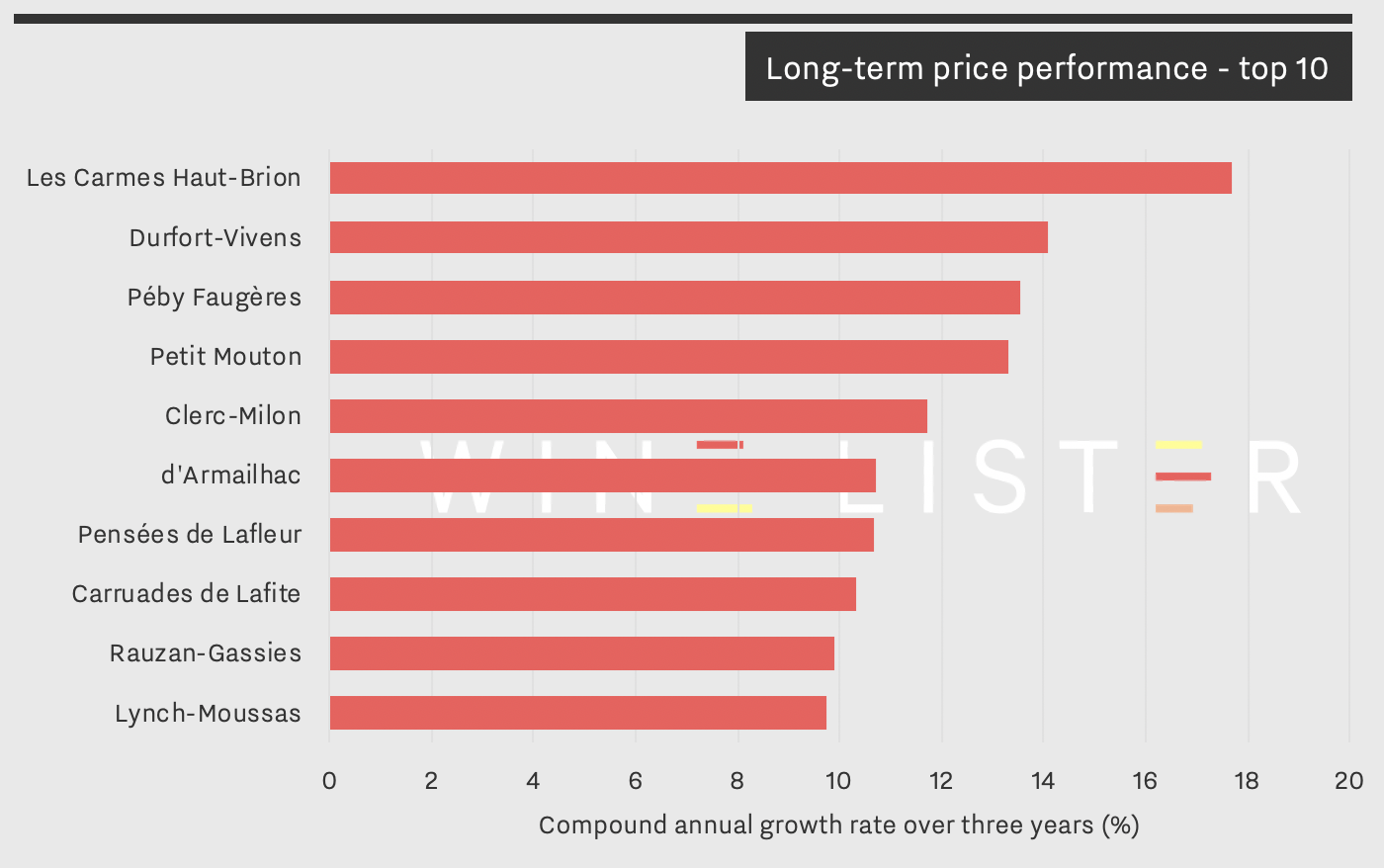 Of major Bordeaux brands, Petit Mouton achieves an average three-year CAGR (compound annual growth rate) of 13.3%, placing it in fourth place of the top 10 long-term price performers, as shown above.
Of major Bordeaux brands, Petit Mouton achieves an average three-year CAGR (compound annual growth rate) of 13.3%, placing it in fourth place of the top 10 long-term price performers, as shown above.
The other 2019s in the Mouton stable, d’Armailhac, Clerc-Milon, and Aile d’Argent were also released today, at prices (per bottle, in-bond) of £31, £52, and £60 respectively.
Yesterday’s hot ticket was right-bank royalty, Cheval Blanc, whose release at £375 also offered consumers a substantial discount on the 2018 release price (32%). Though not yet scored widely by critics, using 2018 as a proxy would mean Cheval Blanc 2019 achieves its joint-highest WL score since the 1961 (alongside the likes of recent greats – 2016, 2015, 2010, 2009, and 2005).
Fellow Saint-Émilion Grand Cru Classé A, Angélus, also released yesterday, though its release price in line with the physically available 2015 perhaps makes it look less attractive. There is nonetheless a real step-change in style and quality happening at Angélus, pioneered by the de Bouärd father-daughter team (Hubert and Stéphanie), which could mean this release is worth investing in for the future.
Two further releases of note from yesterday both hail from Saint-Julien. Branaire-Ducru, a Wine Lister favourite, released its 2019 at £29 per bottle in-bond, 25% down on the 2018 release price. Assuming Branaire’s 2019 is on par with 2018 quality, this is an absolute buy, as the estate’s joint best-ever grand vin at a price beneath all other recent vintages on the market. Léoville-Poyferré 2019 was also released, at £51.34 per bottle in-bond. Offering a 25% discount on last year’s release price for the same quality level, the Saint-Julien second growth is worth considering – having tasted it last week, Lister notes that it is “super-fresh, scented, and luscious”.
Also released so far this week are: Beychevelle, Carillon d’Angélus, Coutet, Gazin, Haut-Bages Libéral, Ferrière, La Gurgue, La Tour Carnet, Larrivet Haut-Brion red and white, and Petit Cheval.
As the first major week of Bordeaux 2019 en primeur releases draws to a close, this morning (Friday 5th June) saw the release of the “first of the Firsts”, and the other reds from the Lafite stable.
Carruades de Lafite 2019 opened the stage with a price of £158 per bottle (in-bond), making it the least expensive Carruades available on the market. The Wine Lister team felt the quality of Carruades saw a significant jump up in 2018, and from what we have heard, the 2019 matches it. With this in mind, and given that volume released onto the market is 50% less than last year, this is a sure buy for anyone seeking access to the Lafite prestige with more approachability.
The grand vin, Lafite 2019, has been released at £426 per bottle in-bond – a discount of c.20% on the 2018’s current market price. The crucial factor this year are the volumes available – also 50% less than last year. On top of this, the single tranche released means buyers will only have one shot to get their hands on the 2019 en primeur (as far as we know). Domaines Baron de Rothschild’s Commercial Director, Jean-Sébastien Philippe, calls Lafite a “modern classic” in 2019, with precision, length, and finesse, but impressive ripeness, making it more approachable than the likes of 2018 or 2016.
Both Lafite and Carruades were cited by the trade as seeing sharp rises in demand (see below) according to Wine Lister’s 2020 Founding Members’ survey. Competition to access both of these wines will therefore likely be high.

Lafite’s Pomerol property, L’Evangile, has released its 2019 grand vin at £146 per bottle in-bond, 15% below the current market price of the 2018. Once again, the Wine Lister team noticed a distinct quality step up in Evangile’s 2018, which we’ve heard has been equalled in 2019. The 2019 reportedly expresses well the move towards a more modern style, and a wine of increasing tension, florality, and freshness, without losing the plush Pomerol profile.
Duhart-Milon 2019 has also been released, at £52 per bottle in-bond. Though the release price puts it more or less in line with market prices of back vintages 2018 and 2016, there is justification to be found in the excellent quality that the Lafite team believe is there in 2019. Philippe explains that Duhart-Milon’s vines sit on a cooler terroir than those of the estate’s Pauillac neighbours, which means in cooler vintages, the wine can be somewhat “austere”. The increasing average temperatures that Bordeaux has seen during recent growing seasons (2018, 2016, and 2015 vintages) therefore only serve to improve the quality of Duhart-Milon, and 2019 certainly had its fair share of heat.
Keep up to date with further Bordeaux 2019 en primeur releases through Wine Lister’s twitter, or through our dedicated en primeur page.
This week has seen a flurry of further 2019 en primeur releases, including the likes of Palmer, Cos d’Estournel, and Domaine de Chevalier’s red and white.
Released this morning (Thursday 4th June) are wines from the Guinaudeau family, including one of the most in-demand wines from Bordeaux, Château Lafleur. Lafleur 2019 is available (for the lucky few who can get their hands on it) for c.£1,550 per 3 pack case in-bond – the same release price as in 2018. While this goes against the 30%-35% discount on last year’s prices that the trade believe may just make the 2019 campaign a success across the board, Lafleur is one of the few exceptions to this rule.
Aside from its impressive and consistent quality, Lafleur boasts one of the smallest-sized estates (4.5ha) for any top Bordeaux property. With rarity on its side, the grand vin is the number one performer for price appreciation after en primeur release.

The chart above shows the top five Bordeaux wines for average percentage increase of the last three vintages – 2018, 2017, and 2016, since their respective releases. The last three releases of Lafleur have seen an average market price increase to date of 43% – 9% more than Petrus.
Perhaps also contributing to the popularity of the Guinaudeau family’s wines is their more “Burgundian” approach to winemaking, with vineyards planted on three separate plots of very different soil types, and the final products aiming to reflect these differences.
For those unable to achieve the dizzy heights of an allocation of the grand vin, the estate’s Perrières de Lafleur (available for £256 per 6-pack in-bond for the just-released 2019 vintage) does exactly this, typically showing mineral, chalky notes from its limestone terroir. Perrières de Lafleur was officially “born” last year, after 15 years of research and testing under the wine’s beta pseudonym, “Acte”.
Finally, at the opposite end of the price spectrum to the flagship wine is Grand Village – the family’s Bordeaux Supérieur, whose quality has come on leaps and bounds over the last few vintages. Grand Village is a Value Pick in every single vintage listed on Wine Lister (2018-2013). If the 2019 is anywhere near the quality of last year, it will surely offer the same impressive quality-to-price ratio.
Follow Bordeaux 2019 en primeur releases through Wine Lister’s twitter, or through our dedicated en primeur page.
Wine Lister spent a week in Bordeaux tasting the 2018 vintage in April, and has dedicated the last two months to covering en primeur releases for its Pro Subscribers. After what has been an unpredictable and puzzling Bordeaux en primeur campaign, we have conducted more than 20 interviews with our Pro Subscribers and Founding Members to find out how it went for them.
Below you will find our conclusions on the Bordeaux 2018 en primeur campaign, which combine our own intimate knowledge of the campaign and its peculiarities with invaluable insights from the trade.
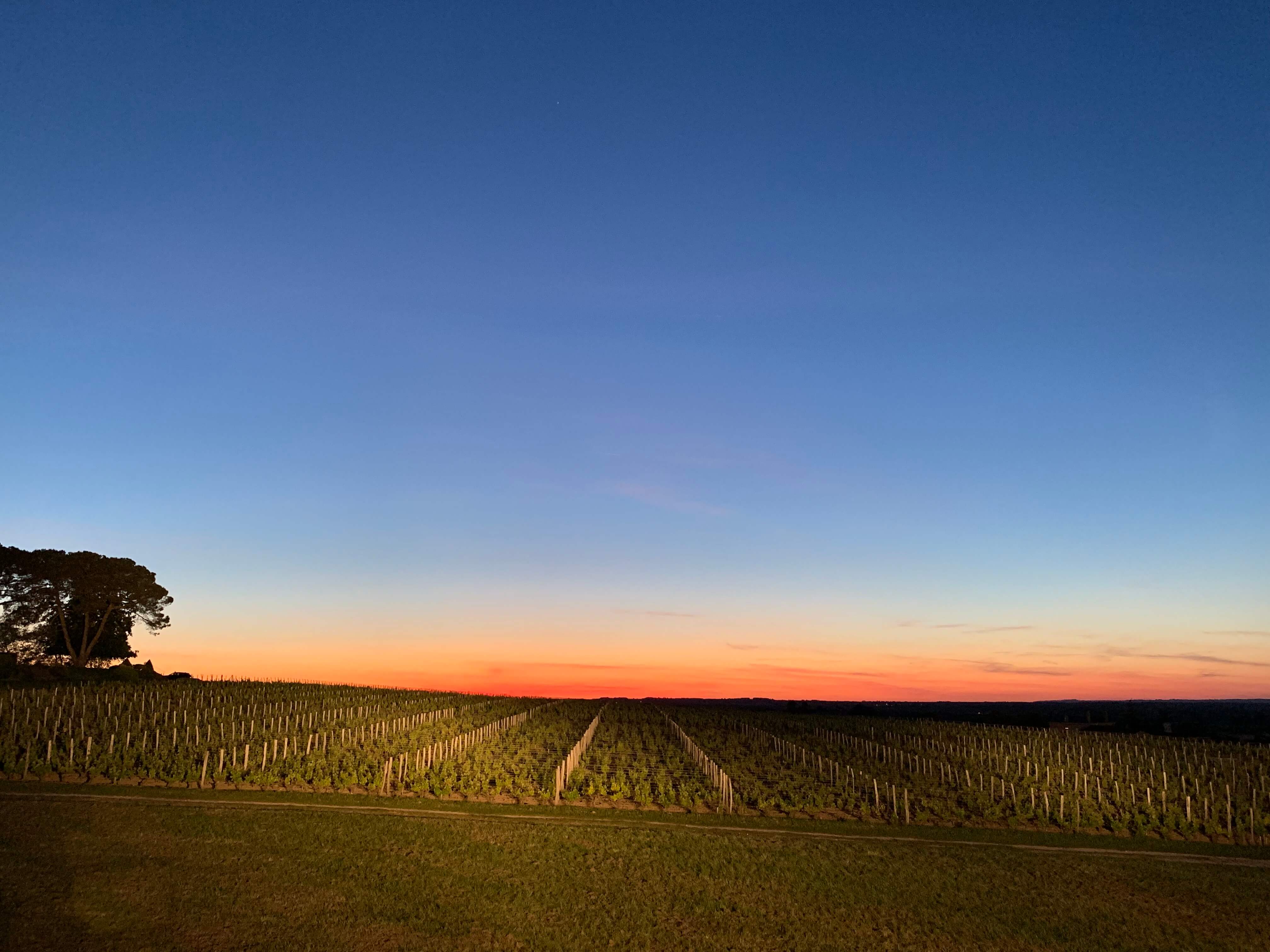
Timing
The campaign lasted 62 days compared to 59 last year (from the date of the first major release to the last standard-channel releases). One clear improvement, thanks to a concerted effort by courtiers, was the spacing out of releases more evenly over the period. However, this did not address the more acute concern around the overall length of the campaign, with the wine trade expected to concentrate on the new Bordeaux vintage for two whole months of the year.
Pricing
A more major frustration was pricing. Over 80% of Wine Lister Pro Subscribers / Founding Members surveyed said prices were too high. On average, prices were up 13% on 2017 and 2% on 2016 release prices. This only made sense where 2016s had gone up in the market since release – not often enough the case. As a result, 2018s came onto the market on average 1% above the current market price of 2016, despite the latter – one of the vintages of the century – being physically available.
Needless to say, many wines stalled upon release due to over-ambitious pricing. When we asked the trade which wines sold the worst, more than once the reply was, “too many to mention”.
Desire
However, one of the more unfathomable motifs of the campaign was that in several instances, this highly ambitious pricing was accepted by the market, and the wines sold through. These were wines with good momentum behind them and a particularly loyal following, but most of all they were wines with a specific story that superseded any thought of value relative to prior vintages.
Examples of this phenomenon are Domaine de Chevalier and Palmer. Both were released into the market above every recent back vintage, and yet both met with demand thanks to the stories behind each wine. Domaine de Chevalier’s owner, Olivier Bernard, started sowing the seed several months before the campaign saying his 2018 was the best wine he’d ever made, a statement reiterated by the rest of his family and gradually absorbed through the fine wine chain. Unable to use conventional sprays, Palmer lost two-thirds of its crop to mildew, and made a striking, unusual wine that Managing Director Thomas Duroux said would “go down in history”.
“The market is very smart and only follows brands that it’s imperative to buy en primeur,” states Laurent Bonnet, Export Director of négociant L.D. Vins.
It was a campaign that favoured top names, not value wines. Wines below €50 were largely unsuccessful (with a few exceptions such as Laroque, Capbern, and Potensac – the three most affordable Bordeaux 2018 Wine Lister MUST BUYs).
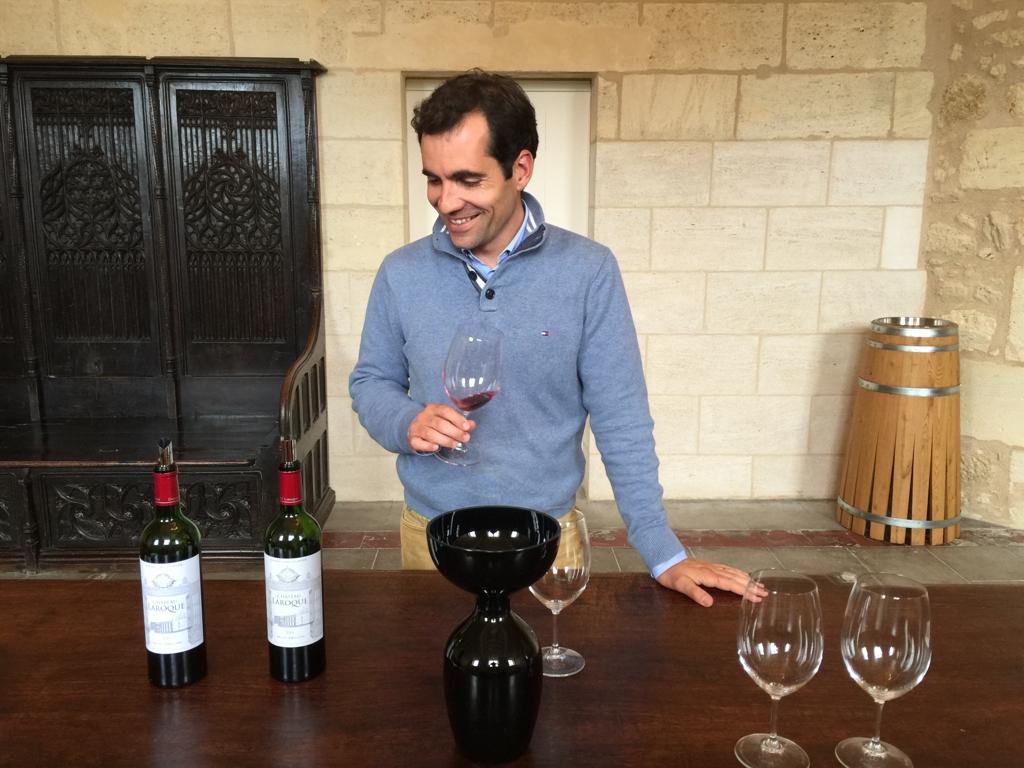
David Suire, Managing Director of Château Laroque – a Bordeaux 2018 WL MUST BUY
Volume
After pricing, the most cited frustration was reduced volumes. On average, leading properties released around 20% less wine than last year. “The number one cause of reduced volumes is lower production in 2018 compared to previous years,” said Mathieu Chadronnier, Managing Director of négociant CVBG, who, like other participants in the campaign would have liked to have more volume to sell of certain wines. “It is a frustration, but there’s nothing we can do about it,” he concluded.
Certainly several properties produced less wine due to mildew and a very dry summer. Others made a commercial decision to keep back more wine – a continuation of the gradual trend for Bordeaux châteaux to release less wine en primeur, whether to create an impression of rarity, and / or to partake in the future upside by selling the bottled wine later once it has – they hope – increased in value.
Bonnet underlines the irony of having less and less stock of the wines that sell well, and too much of those that don’t: “The ‘not enough of in-demand wines / too many wines to hold as stock’ equation is difficult for négociants to resolve,” says Bonnet, cautioning that, “the financial stakes are high.”
Good news stories
While Asian buyers were reported to be less present than in previous years, other geographies remained strong – the US, continental Europe, and especially the UK.
The 10 greatest success stories of the campaign included six Wine Lister MUST BUYs: Calon Ségur, Canon, Carmes Haut-Brion, Rauzan-Ségla, Léoville Las Cases, Mouton Rothschild, and Lynch-Bages.
Revenues were up on 2017 across the board, in many cases very significantly. The majority of respondents reported en primeur revenues the same as or above 2015 levels, with only a couple of exceptions. However, very few managed to equal 2016 revenues.
Future(s)
On the one hand, it seems obvious that the 2018 Bordeaux en primeur campaign could have been more of a roaring success with more astute pricing and in some cases a bit more volume to go around. On the other, many of our Pro Subscribers and Founding Members have been pleasantly surprised by the outcome, and will conclude their campaigns with better revenues than they expected.
This leaves many convinced of the merits of en primeur, if frustrated that it’s not reaching its full potential. “We could have done £35m,” said Max Lalondrelle, Fine Wine Buying Director of UK merchant Berry Bros. & Rudd, which in fact made c.£22m in revenues on the 2018 Bordeaux en primeur campaign.
Meanwhile other members of the trade have ceased their Bordeaux en primeur activity altogether over recent years, and some are questioning its future viability. For the time being, the sun has set on this year’s campaign, but it will rise again next year on the utterly unique global marketing and distribution tool that is en primeur.
Read more about our new MUST BUY tool in our recent blog here.
In Bordeaux, 2018 was a winemakers’ vintage. That much is clear from conversations the Wine Lister team had throughout en primeur tasting week, explained further in Bordeaux 2018 en primeur part I : the vintage. Though quality across the board was good in 2018, the greats stand out all the more for being the result of key technical decisions, rather than just terroir.
Below we look at the top 25 Bordeaux 2018 red Quality scores, based on the recently-released ratings of Wine Lister partner critics Bettane+Desseauve, Julia Harding for Jancis Robinson, Antonio Galloni for Vinous, and Jeannie Cho Lee. The average Quality score of these top 25 is 975, 25 points higher than the equivalent top red panel in 2017.
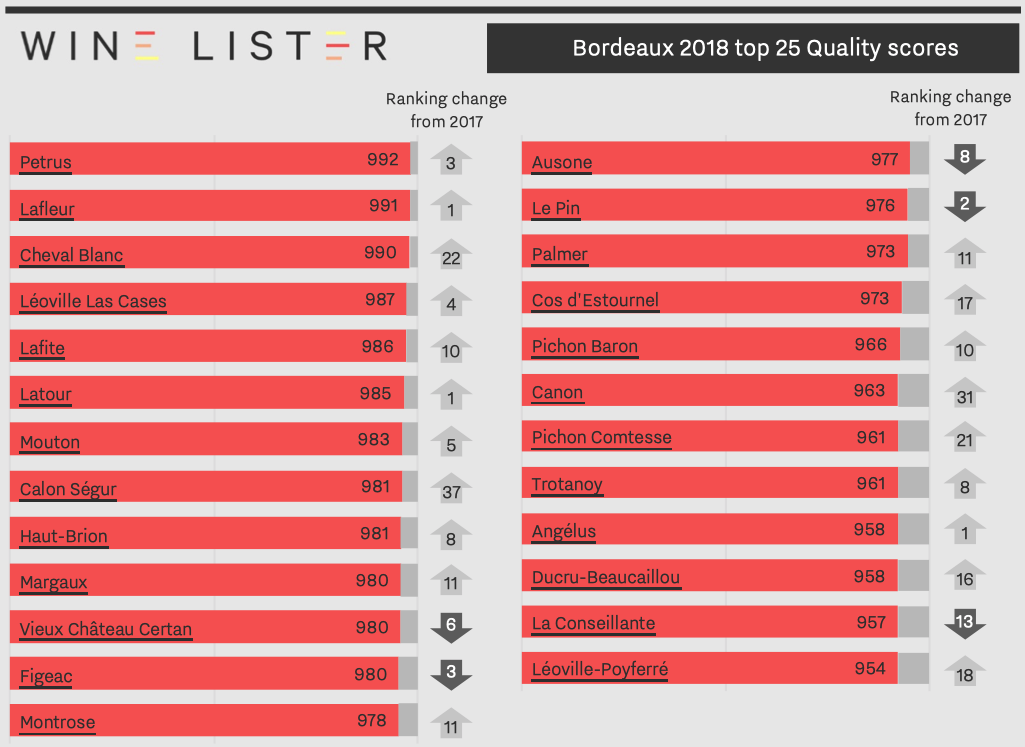
Right bank super-appellation, Pomerol earns the highest number of places in the top 25 red Quality scores (6), and includes the first- and second-best wines of the vintage, Petrus and Lafleur. They earn Quality scores of 992 and 991 respectively, and the former is awarded 97-100 points by Wine Lister partner critic, Antonio Galloni, who comments, “From the very first taste, the 2018 Petrus is simply magical”.
Proving the potential for high quality across both banks in Bordeaux 2018, the next highest appellations are Pauillac and Saint-Émilion with 5 wines appearing in the top 25 apiece. Pauillac wins out overall, with an average score of 976 (vs. 974 in Saint-Émilion). Cheval Blanc (990) and Canon (963) show impressive Quality improvements on 2017, moving 22 and 31 places up the rankings respectively.
Pauillac’s top quality wines are made up, perhaps unsurprisingly, of the three Pauillacais first growths, Lafite (986), Latour (985), and Mouton (983), and super-seconds Pichon Baron and Pichon Comtesse. This last is holds the appellation’s most-improved ranking, moving up 21 places from its 2017 position. Julia Harding of JancisRobinson.com writes of Pichon Comtesse 2018, “A gentle and surprisingly subtle beauty”.
Elsewhere on the left bank, Saint-Julien and Saint-Estèphe earn three wines each in the top 25 for Quality. The best of these, Léoville Las Cases, earns a Quality score of 987. The three Saint-Estèphe wines follow consecutively, with front-runner and rising star Calon-Ségur moving up 37 places from its 2017 ranking – the largest improvement of all the top 25 Quality scorers in 2018.
Margaux and Pessac-Léognan appear just thrice between them in the top 25 for Quality, with Margaux (980), tiny-production Palmer (973), and Haut-Brion (981).
Other wines featuring in the top 25 Bordeaux 2018 Quality scores are: Figeac, Vieux Château Certan, Montrose, Ausone, Le Pin, Cos d’Estournel, Ducru-Beaucaillou, Léoville-Poyferré, Angélus, Trotanoy, and La Conseillante.
Last week, members of the Wine Lister team were in Bordeaux tasting hundreds of Bordeaux 2018s en primeur. Our full report of the 2018 vintage (similar to last year’s article on 2017) will be out soon, and in the meantime we examine below some 2018 tasting highlights.
Quality across the wines we tasted is extremely high. We have selected 42 highlights, including 10 underdogs – those wines we felt surpassed our quality expectations.
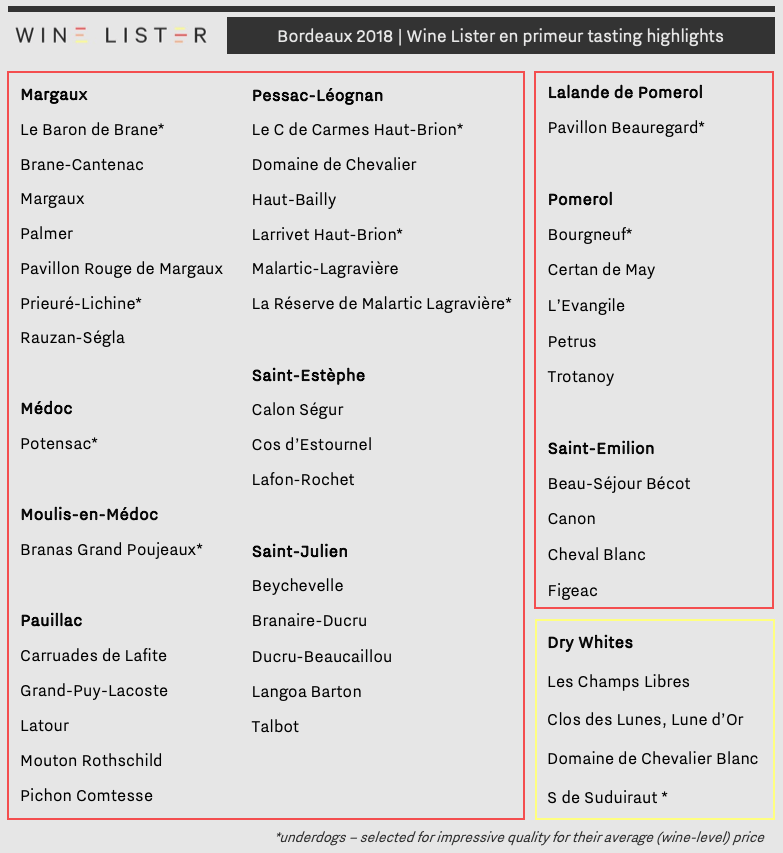
The Wine Lister team found beautiful wines in all the left bank appellations. Margaux and Pessac-Léognan appeared the most consistent for high quality, earning seven and six highlights respectively. These two appellations are home to five of Wine Lister’s 10 underdogs of 2018 en primeur tastings.
The former includes its first-growth namesake, Château Margaux, which was precise, addictive, and harmonious. Pavillon Rouge de Margaux also made the cut thanks to its intriguing and soft fruit character. Brane-Cantenac is becoming a Wine Lister staple after appearing in both 2016 and 2009 tasting highlights. Its 2018 was pure, fresh, and a perfect balance between power and finesse.
In Pessac-Léognan, Domaine de Chevalier had piercing intensity balanced with a floral softness, while Haut-Bailly impressed with a playful fruit character and velvet texture.
Elsewhere on the left bank, Branas Grand Poujeaux surprised with its classy, energetic, dark fruit. Pauillac produced examples of intense fruit handled with a delicate touch (Grand-Puy-Lacoste and Pichon Comtesse). Saint-Estèphe presented beguiling wines with great freshness and elegance (Cos d’Estournel). Saint-Julien showed depth of flavour and complexity in equal measure (Langoa Barton, Ducru-Beaucaillou).
The right bank was just as impressive, with an equal proportion of highlights for Wine Lister as the left (in each case, 19% of wines tasted made the cut). These include one underdog (and new discovery for Wine Lister) from Lalande de Pomerol, five stand-outs from Pomerol, and four from Saint-Émilion.
In Pomerol, Petrus was alluring, generous, and floral, while Trotanoy had delicate strength and never-ending energy. Saint-Émilion produced favourites of varying styles, including Cheval Blanc – a magical, mesmerising boudoir-style wine, and Canon – dancing, racy, and fresh.
Readers should note that these 42 wines are some of the team’s favourites from last week’s tastings, but that we will be releasing official Wine Lister Buys throughout the campaign as prices become known. WL Buys take into account a wine’s quality (based on our partner critics’ scores, which we look forward to adding as soon as they are released), and value within the vintage and appellation, as well as Wine Lister’s personal opinion based on our own tastings and market insights.
Trade members wishing to gain full access to Wine Lister’s en primeur campaign coverage will need to subscribe to Wine Lister Pro. Register your interest here.
Much of the U.K. wine trade gathered last week for the first wine ‘event’ of 2019 – Bourgogne Week. To the Wine Lister team members attending tastings in London, one thing was abundantly clear – the quality across the board is impressive (Wine Lister’s founder, Ella, discussed what a positive surprise the 2017 Burgundy vintage has been in a recent podcast – watch here).
Since there is so much to choose from, and with Burgundy’s popularity continuing to grow (read more in Wine Lister’s Burgundy study here), the Wine Lister team has put together its own list of buys based on tastings attended last week.
The Côte de Nuits has produced many rich examples in 2017. All of Comte Liger-Belair’s wines were stunning, but a particular highlight was his Vosne-Romanée. Both Clos de Vougeots from Faiveley and Jacques Prieur possessed great intensity, while Fourrier’s Gevrey-Chambertin Combe aux Moines was pretty and elegant in style.
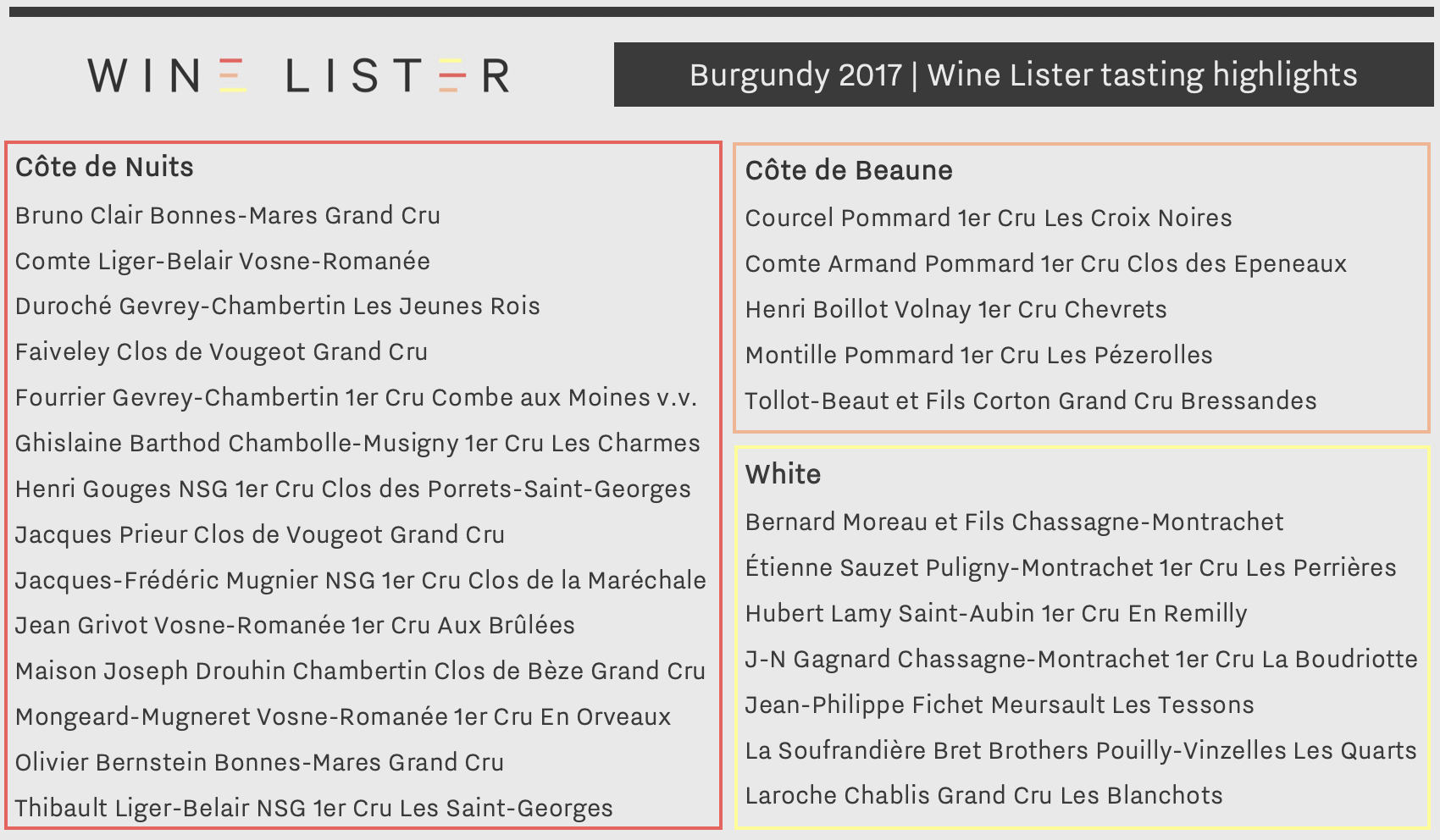
The Côte de Beaune has performed wonderfully in 2017. The team settled on a Volnay, a Corton Bressandes and three Pommards, with two particular favourites – Comte Armand’s Clos des Epeneaux and De Montille’s Les Pézerolles.
Finally, the team were impressed by an array of whites from the Mâconnais right up to the premiers crus from the Côte de Beaune. Hubert Lamy’s Saint-Aubin En Remilly was selected unanimously by Wine Lister team members. Bernard Moreau’s Chassagne-Montrachet impressed, while Bret Brothers’ Pouilly-Vinzelles Les Quarts was a great discovery.
See the rest of the wines included in this post here: Bruno Clair Bonnes-Mares, Duroché Gevrey-Chambertin Les Jeunes Rois, Ghislaine Barthod Chambolle-Musigny Les Charmes, Henri Gouges Nuits-Saint-Georges Clos des Porrets-Saint-Georges, Jacques-Frédéric Mugnier Nuits-Saint-Georges Clos de la Maréchale, Jean Grivot Vosne-Romanée Aux Brûlées, Maison Joseph Drouhin Chambertin Clos de Bèze, Mongeard-Mugneret Vosne-Romanée En Orveaux, Olivier Bernstein Bonnes-Mares, Thibault Liger-Belair Nuits-Saint-Georges Les Saint-Georges, Courcel Pommard Les Croix Noires, Henri Boillot Volnay Chevrets, Tollot-Beaut Corton Bressandes, Étienne Sauzet Puligny-Montrachet Les Perrières, Jean-Noël Gagnard Chassagne-Montrachet La Boudriotte, Jean-Philippe Fichet Meursault Les Tessons, Laroche Chablis Les Blanchots.
Analysis of the new release of Dom Pérignon 2008, which has received its highest Quality score ever.

You can download the slide here: Wine Lister Factsheet Dom Pérignon 2008
Analysis of Dominus 2015, which was released late last week at £183.33 per bottle, with a Quality score of 988.
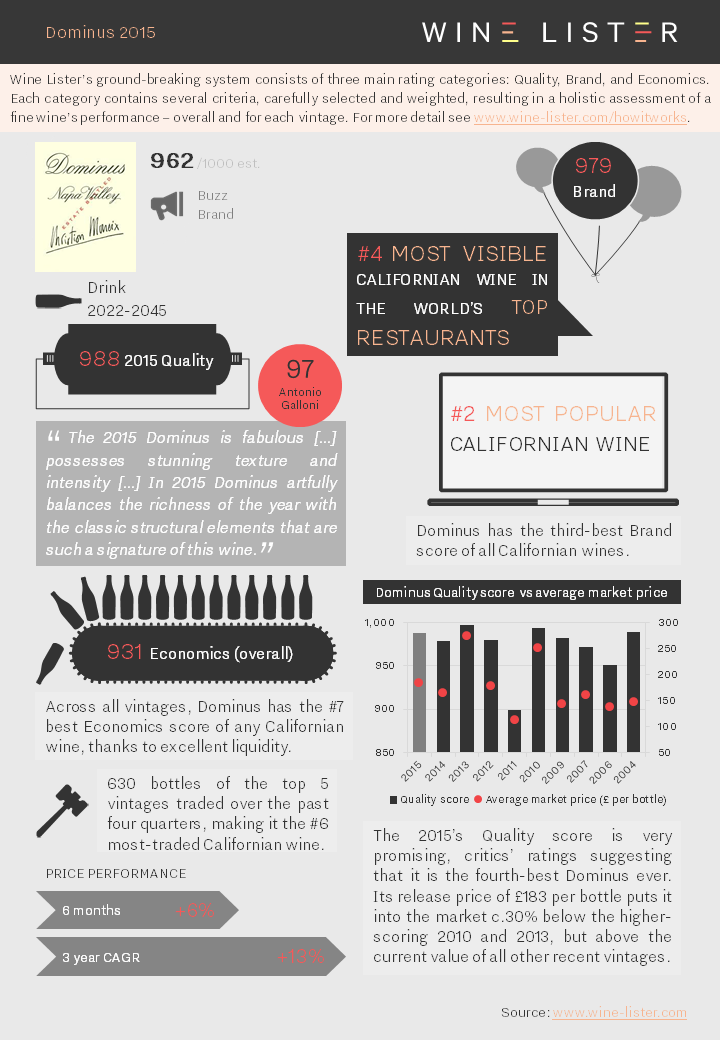
You can download the slide here: Wine Lister Factsheet Dominus 2015




 Of major Bordeaux brands, Petit Mouton achieves an average three-year CAGR (compound annual growth rate) of 13.3%, placing it in fourth place of the top 10 long-term price performers, as shown above.
Of major Bordeaux brands, Petit Mouton achieves an average three-year CAGR (compound annual growth rate) of 13.3%, placing it in fourth place of the top 10 long-term price performers, as shown above.







